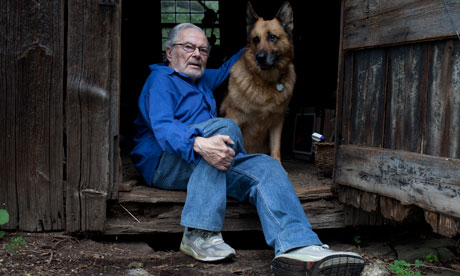
Maurice Sendak, who died on Tuesday, was one of the few – and rare – writers who truly wrote for children. Not to entertain their parents, or to improve their social skills – he told the stories that children live themselves, wobbling on the uncomfortable brink between dreams, imagination and reality, where truth is whatever can be remembered, whether it really happened or not.
Sendak wrote about dreams and monsters, cake mix and kidnappings, rescue and dressing up. The children in his books are messy, disobedient, ghastly and undisciplined – Max, from Where the Wild Things Are is the worst, of course, causing havoc in the wolf suit. But then there is Mickey, naked in the batter, and Rosie, from The Sign on Rosie's Door, who takes on the persona of music hall diva and all round bossyboots, Alinda, the Lovely Lady Singer. And yet, these children did not get their comeuppance – these are no cautionary tales – there is no gruesome moral shoving a reluctantly impressionable reader towards conforming to the neat, the quiet and the un-troublesome. Instead, they wake up happily in their beds, supper is still warm, there is milk in the morning. If a lesson is learned, it is by choice, not enforced by punishment.
Sendak's children are given the power to overcome the monsters, to escape the creepy night-time bakers. They are crowned kings, and have sufficent influence to make everyone "be still"; they can fashion dough into an aeroplane and fly away – no wonder children don't find his books as unsettling as adults do. Even being sent to your room is no hardship, when the walls become the world all around, and you can sail off in your bed to wreak havoc elsewhere. Sendak makes children the promise of growing up. One day this will come true, and you will have the opportunity and the means to leave, and to choose, and yes, perhaps you will choose to sail back to mother, but by then she will be lucky to have you.
I was probably reading the book to my daughter before I realised that Max's journey could be interpreted as a dream, while in the recent film of the book, the little boy was running away from generic "problems at home". To a child, these explanations and justifications are quite unnecessary. The realisation of our own dreadful permanence is one of the longest, and most disappointing lessons we learn as children. Children dress up, make-believe, pretend, hide behind their hands, not because they want to be entertaining, or cute, but because they truly believe that there is, or will be, a moment of genuine transformation when they will disappear, and become somebody else. In Sendak's hands, this faith is justified. His children get the instant transformation that his readers will have to wait for, and work at; they don't have to compromise, or be realistic, or calm down, or behave do any of the things that agitated adults insist upon.
Although Sendak's work can seem dark, and a little unsettling (my favourite of his illustrations is skinny, sinister Mr Rabbit, from Charlotte Zolotow's book – surely an influence on Donnie Darko), the freedom that he allows his children to be scared, to be wild, to be naughty, to be unlikeable, and yet still to be loved – will always be a comfort.
• Follow Comment is free on Twitter @commentisfree

